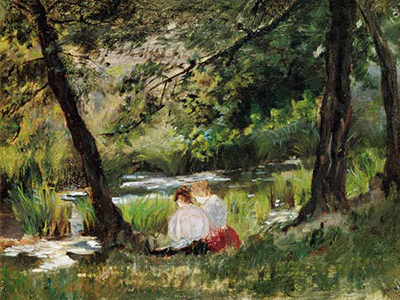Two Women Seated by a Woodland Stream is an early example from the career of American Impressionist, Mary Cassatt. She would only have been in early mid-twenties at the time that she produced this work.
Here in front of us we find two female figures sat besides some trees in a rural setting. A pretty river snakes past at the bottom of the scene and a flurry of reeds line the bank immediately in front of them. Light is carefully used by the artist here in order to give the impression of gaps between the trees, with a clear contrast in different parts of the painting. The girls themselves are happy to avoid the sun, as would have been the fashion during the 19th century, where the upper and middle classes would desire paler skin which was considered more attractive at the time and also represented a higher role in society. The overall content and balance of light feels very much in line with the standard approach of the Impressionist artists and Cassatt would exhibit alongside other members as she started to spend time in their company. There are many examples from other great names within this movement which bear a resemblance to the content found within Two Women Seated by a Woodland Stream.
Cassatt took time to get her career off the ground and would not really peak as an artist until several decades after this painting was completed. She would also move into pastel work too, and collaborated with Degas for a number of years, with the two striking up a strong relationship based on deep artistic respect. Cassatt features two female figures here but became more famous for standard portraits, featuring mothers with their young children. That would become her signature genre and received rejection and praise in equal measure, though eventually her clear technical talents were accepted by the majority and her identity as an American woman was given less attention. She was strong willed and this became an essential characterstic in order to survive a male-dominated world, which the late 19th century undeniably was.
It was entirely rare for an American artist to become so deeply embedded in the French art scene of the 19th century but that is precisely what Mary Cassatt managed to do. She was initially urged against entering a career in art by her parents but eventually chose to do so anyway and it took time for her talents to be recognised. Ultimately, she would provide an important sphere of work that otherwise would not have been contributed to the Impressionist movement as she worked from the female perspective, and this showed very much in the unique nature of her oeuvre. There were several other female members too, but they did not devote as much time to capturing the forgotten women of a male-dominated society and so her work would play an important role in fostering societal change. Similar was achieved by Berthe Morisot, with the likes of The Cradle, Woman at her Toilette and Summer's Day.




